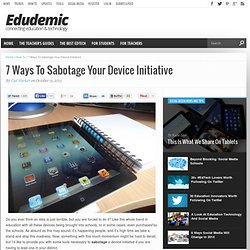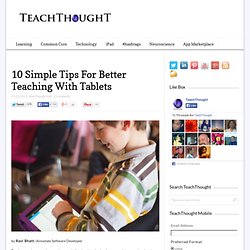

7 Ways To Sabotage Your Device Initiative. Do you ever think an idea is just terrible, but you are forced to do it?

Like this whole trend in education with all these devices being brought into schools, or in some cases, even purchased by the schools. As absurd as this may sound, it’s happening people, and it’s high time we take a stand and stop this madness. Now, something with this much momentum might be hard to derail, but I’d like to provide you with some tools necessary to sabotage a device initiative if you are having to lead one in your district. 1.
Go REAL fast Technology changes by the milli-second, so there is a sense of urgency to go from pilot to full-fledged implementation overnight. 2. A leader trying to make a splash in student learning doesn’t have time to get buy-in from everyone. 3. Everyone always says these devices are for instruction, but let’s be honest – the people who should choose them are the people with the least amount of instructional background. 10 Simple Tips For Better Teaching With Tablets. By Ravi Bhatt, iAnnotate Software Developer Teachers can’t escape the growing trend of technology in the classroom.

It’s more than just hype. More schools are buying tablets for use in the classroom, with Apple’s tablet sales to the education sector doubling last year. As a mobile software company whose product is used extensively in education, we dream big about the future of technology in the classroom. We have worked with numerous great teachers who have successfully leveraged tablets to improve the learning experience for students.
Are you tempted to join the trend? 1. Ensure curriculum is tablet-friendly. 2. Practice before you deploy. 3. Nexus 7s and 10s are not iPads are not Windows Surface Tablets. Accordingly, you’ll need to test-drive the selection of the tablets students will use. 11 Sample Education BYOT Policies To Help You Create Your Own. We’re putting together some research for some upcoming BYOT policy content, and in the course of doing so found many existing policies enlightening.

For starters, it is clear that some districts were more open-minded entering their BYOT programs than others. Many “policies” (not included below) were really more of a set of rules and consequences for breaking the rules than they were a supporting framework for teachers and students. In the end, every situation is different. There is no single “right way” to implement a BYOT program, so we’ve included 11 widely varying policy styles below, with each authoring school or district named inline. Bowling Green High School “Bring Your Own Technology” (B.Y.O.T.) Responsible Use Guidelines Purpose: Bowling Green High School uses instructional technology as one way of enhancing our mission to teach the skills, knowledge and behaviors students will need as responsible citizens in the global community. Device Types: Guidelines: Usage Charges: Planning for BYOD: 10 Checklists to Help Make the Move. 10 BYOT / BYOD Back to School Basics.
5 Leadership Strategies for Implementing BYOT. Bring Your Own Technology (BYOT) is essentially a “bottom up” initiative in the sense that students already have personal technology devices in their pockets, and they often provide the incentive or demand to begin using those tools for instruction.

The IKEA Effect of BYOT. Many of us have ordered furniture or other items from IKEA and spent a weekend assembling those products to be proudly displayed as our handiwork.

Earlier this year on National Public Radio, Shankar Vedantam, author of The Hidden Brain, reported a story in Research News entitled “Why You Love That IKEA Table, Even If It’s Crooked.” The basic premise of this research is that when we labor at something that we personally create, we value it more although it may have some imperfections. According to research by Mochon, Norton, and Ariely (2012), Building your own stuff boosts your feelings of pride and competence, and also signals to others that you are competent. This phenomenon is known as the IKEA Effect, and it has repercussions that could extend beyond the field of business marketing. As I listened to the broadcast, I reflected on the IKEA Effect’s possible implications for learning within the Bring Your Own Technology (BYOT) classroom.
Engagement Publishing. The challenges of putting computers in schools and BYOD – Opinion – ABC Technology and Games. The Digital Education Revolution (DER) was supposed to make technology a ubiquitous part of the secondary learning experience by outfitting students with small, robust laptops in Year 9 and providing a school-wide wireless network.

With this unprecedented access to mobile computing technology, a thousand flowers of digital educational innovation would surely bloom. Well, it was fun while it lasted. But the program is unlikely to be renewed. Whilst support is guaranteed until the last cohort to receive DER laptops graduates in 2016, schools will be trying to decide what the next step will be in a world where access to computing power has become ubiquitous, inexpensive and exists across a vast range of different hardware and operating systems.
The solution being given increasing attention is Bring Your Own Device (BYOD). Ivan (not his real name) remembers the first year of the laptop roll-out well - he was in Year 12 at a school in Sydney's western suburbs.